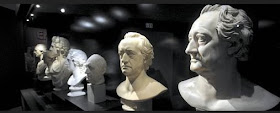Hofmann begins by characterizing the biographies of literary figures by Anglo-American biographers, in particular praising Nicholas Boyle. He was on board with Boyle when he learned that the cost of pineapples in Goethe's time was about the price of a horse, or and the time it took to send a letter from London to Edinburgh was a week. Safranski in contrast, Hofmann complains, "doesn't feel the need to locate Goethe for a non-German readership. ... Dozens of obscure names scoot past the reader's eye with nary a word of introduction or presentation." Hofmann is of the opinion that the book is aimed "squared at a German readership of Bildungsbürger ..." As I wrote in my review, however, the book is really for Goethe aficionados. Do educated Germans today have any idea who Bertuch is, not to mention Goertz, Rochlitz, Kanzler Müller, Falk, Riemer, men introduced by their last name by Safranski and in most cases not even specifically identified?
Basically, Hofmann faults Safranski for what he does not do, complaining, for instance, that Life as a Work of Art does not bring out Goethe's English connections. I also mentioned such absences in my review, indeed, the absence of the larger European context. But Safranski's focus was the inner life, especially the difficulty Goethe had in conforming his innate character to the demands of life, love, work. It was a lifelong task; thus, Kunstwerk des Lebens. For me, what was striking and illuminating about Safranski's biography is his portrayal of Goethe's emotional volatility and grandiosity. In literary terms, these were channeled in the works of the Sturm und Drang epoch. And as Goethe aged out of Sturm und Drang, he went on to channel these emotional tendencies into an immense variety of projects.
Daniel Johnson begins by corralling Goethe into the company of Homer, Dante, Shakespeare, and so on and relates his importance to Carlyle, Arnold, Eliot, Mann. Johnson apparently attended a German Gymnasium in 1974, when Goethe "was still at the heart of the curriculum." No more, not even one assumes for the children of so-called Bildungsbürger. As Johnson points out, today most Germans today have only a vague idea of who Goethe was and when he lived. While he contends that a "highly cultivated bourgeoisie" still exists, it never fully recovered from the destruction of German Jews. This brings us back to Goethe's importance to Western civ, addressed at the beginning of the review. Goethe may not have been a philosemite, bu "the history of Goethe scholarship was largely a Jewish affair until the 1930s," with an emphasis on Goethe's universality and cosmopolitanism. Recent European history, especially the migrant crisis, illustrates the problematic status of these. Perhaps, Johnson writes, this is "a good moment ... to rediscover Goethe."
 |
| Caravaggio, Supper at Emmaus (National Gallery, London) |
As I wrote in my own review of the German edition, Safranski's approach yields insights concerning the transition from Goethe's youth, when his grandiosity, depressiveness, and his charisma were on view. Take this comment by a friend from his Strassburg days: "Dieser Goethe, von dem und von dem allein ich ... stammeln und singen und dithyrambisieren möchte. .... Noch nie hätt ich das Gefühl der Jünger von Emmaus im Evangelio so gut ... mitempfinden können ... Machen wir ihn immer zu unserm Herrn Christus, und lassen Sie mich den letzten seiner Jünger sein!" It was after an initial raucous initial period in Weimar that his outer affect became more serious and that the stiffness noted by friends like Merck and Wieland began to emerge.
Photo credit: Peter Michaelis

No comments:
Post a Comment